Foreword
In September 1997, Sri Chinmoy requested me to compile his reminiscences about Dr. Sisirkumar Ghose, who was one of his main mentors during his formative years. Sri Chinmoy gave this collection of stories the title:
My Santiniketan Sisir-da:
My Mentor of a Fully Blossomed
Lotus-Heart
I was greatly helped in finding background information about Sisirkumar Ghose by his great-niece, Mahatapa Palit,1 who had become Sri Chinmoy’s student several years earlier. She was able to provide a detailed biography and many rare photographs of this eminent scholar. I also have a personal connection with Sisir Ghose, which adds another thread to this unique tapestry.
These stories were told by Sri Chinmoy over many years. He read the entire collection aloud to Arun Ghose, Mahatapa’s uncle and the nephew of Sisir-da, during Arun’s visit to New York on September 27th, 1997. At that time, Sri Chinmoy made many additions and improvements to the manuscript. The stories are all presented in his first-person speaking voice, as they were originally recorded.
– Vidagdha Bennett
Table of Contents
|
|
|
My Santiniketan Sisir-da:
My Mentor of a Fully Blossomed
Lotus-Heart
Dedication by Sri Chinmoy
Sisir Ghose lived most of the time in Santiniketan, West Bengal, where he was a Professor of English, an authority on the writings of Rabindranath Tagore and a world-renowned scholar of mysticism. But, from time to time, he used to come and stay at the Sri Aurobindo Ashram.
My beloved Sisir-da was unswervingly kind to me. He was unreservedly affectionate to me. He was unconditionally indulgent to me. He was undoubtedly an Himalayan mentor in my formative years at the Sri Aurobindo Ashram. He showed me how an ocean of knowledge-light can at once lovingly and unassumingly play with a very tiny and shallow pond. My heart’s gratitude-flames I am most soulfully offering to his heart’s compassion-sun. I bow in all humility to a most precious diamond of Tagore’s Santiniketan.
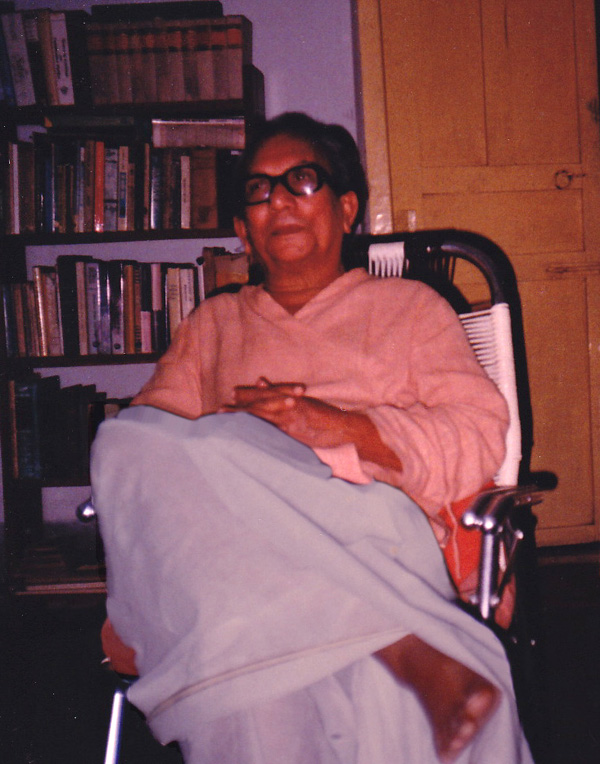 |
|
Dr. Sisirkumar Ghose2 |
1. Sisir-da’s Unalloyed affection
In so many ways, Dr. Sisirkumar Ghose – my Sisir-da – blessed me with his unalloyed affection and fondness during my youth. I shall never forget the way he would suddenly appear and grab my shoulder and compel me to walk with him here and there.
When my friends of my own age saw that I was going somewhere, they would often come running to walk with me. I had one friend, by name of Prahllad, who would even drop his bicycle in the street so that he could walk with me.
But Sisir-da was considerably older than I was and so he treated me like a little brother. He used to call out, “Hey, Chinmoy!” Then he would place his hand affectionately and powerfully on my shoulder in front of everyone and turn me around so that I could accompany him. I had to make an about-turn! He never asked me where I was going; he would just grab me and pilot me in his usual way. Then we would walk and walk.
One incident stands out in my memory. Evening had fallen. He grabbed me by the shoulder and compelled me to walk at least two miles with him along the shore of the Bay of Bengal. He was talking and talking of literary things the whole way. Now and then, he would quote from Sri Aurobindo’s “Savitri”. I was a silent listener and devoted admirer. By the time we came back, it was eleven-thirty or so. He had to drink a cup of tea. Now, where would he get tea at that hour? My cousin Nirmala was very nice. We went to her place around midnight and she made tea for him. In those days, I did not drink tea.
I learnt so many things from Sisir-da during our walks together. Truly, his was the wisdom-ocean.
2. My Sisir-da
Half a century has elapsed since those days. Strangely enough, I have only recently come to learn that Sisir-da was born in 1919. That means he was my senior by only twelve years. To me, the difference in our ages seemed more like twenty years. He was so mature that he looked much older than his actual age. Perhaps his long years of reading and studying contributed to this impression.
He once told me that he had a very special friend who would stay by his side the entire night through. He asked me to guess who this friend could be. I was bewildered. Sisir-da, with twinkling eyes, said: “You fool! You do not know who my special friend is? It is my English dictionary!”
Sisir-da had wavy hair and his eyes were very, very beautiful. His voice was sweet, high and melodious, like Tagore’s voice. As a West Bengali, he had excellent Bengali pronunciation. I deeply admired his Bengali pronunciation and tried to emulate it wherever possible, for I myself, being born in Chittagong, feel that my Bengali pronunciation is quite inferior to that of people from West Bengal, specially scholars like Sisir-da.
3. Sisir-da’s Eldest Brother
Sisir-da had four brothers, but he used to speak to me most often about his eldest brother, Santosh, whom he adored. He would say, “I am nothing in comparison to him. He was much more brilliant than I am. How I wish you could have seen my eldest brother!” And tears would shine in Sisir-da’s eyes.
Whenever I praised Sisir-da’s literary writings or his Bengali handwriting, which was extremely elegant and beautiful, he would say the same thing, “Ah, but my eldest brother’s literary compositions and handwriting were far, far better.”
This eldest brother had been a professor of English at Patna University where Sisir-da took his B.A. and M.A., but he died at a young age. Sisir-da used to support this brother’s wife and children. How he cherished the memory of his eldest brother!
4. Sisir Ghose’s Two Homes
Sisir Ghose was a brilliant scholar. Many of his lectures were printed serially in The Statesman. He lived most of the time in Santiniketan, West Bengal, where he was a reader/lecturer/professor at Rabindranath Tagore’s Vishwabharati University. But from time to time, he used to come and stay at the Sri Aurobindo Ashram.
For literature and culture, Tagore was his Guru; and for spirituality and yoga, Sri Aurobindo was his Guru.
5. Affection Compels Surrender
Once an Ashramite named Damodar, who had studied at Santiniketan for some time, asked Sisir-da to elucidate certain aspects of Sri Aurobindo’s “Savitri”. Sisir-da asked me to be present when he answered the questions. By then, I had read Sri Aurobindo’s epic seer-vision poem eight or ten times, but since I did not go beyond the barrier of high school, I am further than the furthest from being a scholar. From my earliest childhood, however, I have been a poet and each time I read “Savitri”, I absorbed and learnt so many difficult English words that are not to be found in most of the dictionaries. As to the subject itself, I knew that Sri Aurobindo had taken an episode from the Mahabharata as his theme but, to be perfectly sincere, I could not understand the poem well, no matter how many times I read it. So I told Sisir-da that I was not the right person to hear his discourse.
He said, “Chinmoy, ‘Savitri’ is not a matter of understanding. It is a matter of loving and admiring. You have read the poem so many times. That proves you genuinely love it. So, in what way are you inferior to one who has merely studied the poem on a mental level?”
Then he compelled me to go with him and listen to his most eloquent discourse. It lasted for forty-five minutes and I gained so many new and deep insights into the meaning of “Savitri”. This is the nature of affection. When somebody makes affectionate demands of you, you have no choice but to surrender, unconditionally surrender.
Sometimes, I would see him when I was on my way to the dining hall. I would be so hungry, absolutely dying to go and eat, but that was the time he was inspired to explain to me some portion of “Savitri”. He would tell me, “I know you have not understood it.” Then he would make me sit in one corner and he would read me the passage and explain everything to me.
6. Visitors from Santiniketan
In 1958, some years after Tagore’s passing, twenty Santiniketan students came to the Sri Aurobindo Ashram to take part in our athletics competition. In some items, we Ashramites defeated the Santiniketan students and, in some, they defeated us. I participated in the decathlon. That was the day I destroyed my right elbow throwing the javelin. In the 100-metre race, I defeated the Santiniketan students, but I lost to my German coach, Saumitra,3 badly.
The group of students from Santiniketan stayed at the Ashram guest house for two nights. They were of my age and so I mixed with them a little. I came to know that Sisir Ghose was the English Professor of the fellow who ran with me in the 100 metres.
Later, when I informed Sisir-da, he said, “He is a very bad student, but he is very good in athletics. I tried so hard to give him a good mark for English, but I could not.”
7. Sisir-da creates a Problem for Me
In 1957 or 1958, out of sheer joy and love, Sisir-da gave me a small picture of the Mother, Rabindranath Tagore, Paul Richard and W.W. Pearson standing together. He said, “Chinmoy, take it. This is something sacred.”
The picture was taken in 1917, long before I was born, in front of the huge statue of the Lord Buddha at Kamakura in Japan. The picture was so special because four very significant human beings, four world famous figures, were standing side by side.
I was so delighted and excited to receive the picture and I lost no time in showing it to my boss, Nolini Kanta Gupta, who was the main secretary of the Sri Aurobindo Ashram. I thought he would share my happiness. To my astonishment, Nolini-da became furious. “Who gave you that picture?” he demanded.
I did not want him to be mad at my Sisir-da, so I said, “ I have forgotten.”
“How could you forget this kind of thing?” said Nolini-da. “You only received the picture yesterday.”
Then he confiscated the picture from me. In one fell swoop, I lost the picture and I was blessed with a severe scolding.
When next I saw Sisir-da, I said to him, “You have done me a big favour! That picture landed me in such serious difficulties with Nolini-da.”
He said, “I had no idea it would create problems for you. I thought you would be so happy.”
 |
|
A Buddhist priest, W.W. Pearson, Rabindranath Tagore, Mirra Richard (The Mother) and Paul Richard before the Lord Buddha in Kamakura, Japan, 1917. |
The Cosmic Game of our Lord Beloved Supreme is such that the story does not end there. Although I had seen the picture only fleetingly, that particular statue of the Lord Buddha remained fixed in my mind. It was beyond my imagination that I would one day go to Japan and meditate at that sacred place. But that is exactly what happened. Since my first visit to Japan in 1969, I have made my pilgrimage to Kamakura seven times to pray and meditate before the Lord Buddha. To me, this statue embodies his His consciousness more than any other that I have seen.
In December 1996, the Head Priest of the Kotoku-In Buddhist Temple in Kamakura, who has become a very close friend of mine, most compassionately allowed me to offer a Peace Concert at the feet of the Lord Buddha. I was so deeply moved and honoured to do so, and I shall always remain grateful to him for this singular opportunity to express my love and devotion.
 |
|
Sri Chinmoy meditating in front of the Kamakura Buddha many years later. |
8. A Most Precious Gift
At the end of 1960, Sisir-da went to America and gave quite a few talks at Missouri University and various other places on philosophy, literature and so forth. When he was in New York, he stayed in Greenwich Village. There he bought a statue of the Lord Buddha as a present for me. When he came back to the Ashram in 1962, he gave me the statue and told me where he had bought it.
I asked, “Is it a village?”
I simply had no idea that in only two years I would come and live in Greenwich Village. I always say that in Greenwich Village there is no night; it is all day. There is so much light in the street.
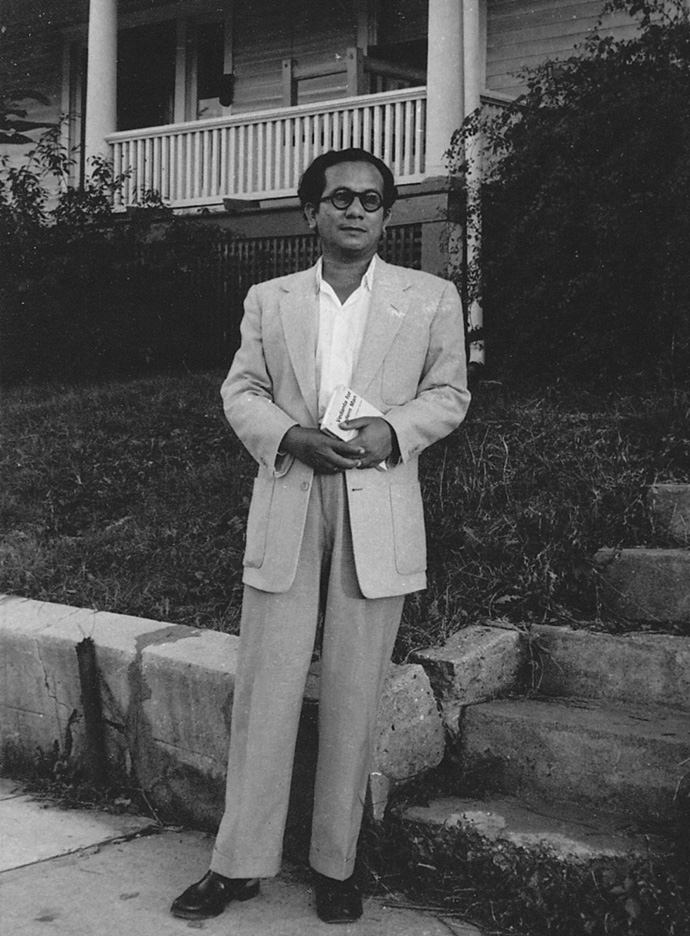 |
|
Sisir-da in America, October 1962. |
9. Sisir-da’s Most Significant Prediction
It was arranged that Sisir-da would give a talk at the Ashram about his trip to America. Four or five hundred people came to hear him at the playground. It was around nine o’clock in the evening. I was sitting in the audience, about twenty metres away from him, in the fourth or fifth row. He was reading out his memoirs.
All on of a sudden, out of the blue, he pointed to me and said, “I can clearly see that in a few years this fellow, our Chinmoy, will go to America and create a commotion!”4
Everybody in the audience burst into laughter because they thought it was all an hilarious joke. I did not know any Americans at this time but, in only two years, Sisir-da’s prediction came true. He was the first one to make the prediction that I would come to America. How did he have that vision in 1962? God alone knows. I was not even thinking of America. My mind was flying quite often to the Himalayas to resume the life I led in my previous incarnation.
10. Two Great Rival-Friends
Sisir Ghose and K.D. Sethna,5 the editor of Mother India, were two great friends and rivals. At the same time, both of them were my mentors. For years and years, they would not speak together face-to-face. But each one saw that I was mixing with the other one. So Sisir-da used to ask me, “How is Amal-da?”6 And K.D. Sethna used to ask me, “How is your Sisir-da?”
I was in between these two great literary figures. Quite a few times, Sisir-da would give me his writings to take to K.D. Sethna to print in Mother India. But if Sethna corrected one line, then finished! Sisir-da would not allow Sethna to print it. So both of them were on their high horses.
One day I decided to arrange a meeting between them. I sent an invitation to each one. I knew they would not refuse because they liked me so much. So, after many years, they agreed to see each other. I arranged for them to meet at Sethna’s place. I brought Sisir-da there in the late afternoon. And then both of them started talking and talking and talking, far above my head. I was so happy to see them together.
At one point, they started talking about me. Sisir-da said, “If we had twisted you just a little, given you a little help, you could have become a great scholar. You could have taken your Masters Degree.”
11. A Difference of Approach
While I was listening to Sisir-da and K.D. Sethna exchanging their views on a wide variety of subjects, I noticed one difference between them: I saw that K.D. Sethna’s approach was broad and vast. His sweeping mind was able to encompass everything in a general way. His reasoning was irrefutable and his intuition was penetrating.
By contrast, Sisir-da’s approach was much more specific. He knew so much about Western poets and philosophers that he was able to focus on minute details. On this occasion, however, he showed tremendous respect for K.D. Sethna’s literary knowledge and wisdom. Not only was K.D. Sethna his senior, but K.D. Sethna had the rare good fortune to discuss matters of high poetry with Sri Aurobindo through a series of illumining correspondence. That is why Sisir-da showed his humility in a most genuine way.
12. “For Me, He is a Professor!”
One day I was assisting K.D. Sethna with the forthcoming edition of Mother India. I said to him, “They say that Dr. Sisir Ghose is an excellent professor.”
K.D. Sethna said, “What is this? Why are you calling him ‘professor’? He is not a professor! He is only a Ph.D.”
I said, “He is so vast and great. For me, he is a professor.”
Then K.D. Sethna became furious. “From now on, you have to say that he is a reader. Readers are inferior to professors. You fool! Why do you have to open your big mouth to me!”
What do I know about the difference between a professor and a reader? This is the British system. For me, everyone who teaches at a university is a professor. But on this occasion, I became brave. I said, “Dr. Sisir Ghose will always be a professor to me. When I made the arrangements for you two to see each other after so many years – approximately fifteen years – both of you started showing off and I clearly saw that in some areas he knows much more than you do. That is why I call him professor.”
Then Amal Kiran’s compassion-forgiveness-aspect came to the fore and he gave me a very broad smile.
I made the first and last arrangement for these two literary giants to see each other again.
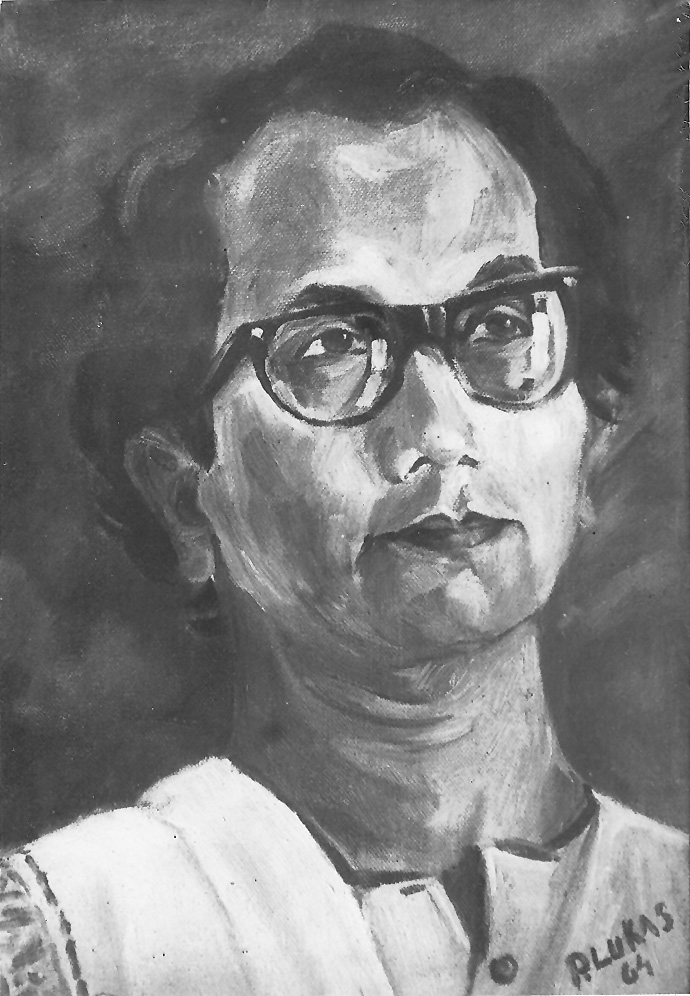 |
|
This portrait of Sisir-da was painted by P. Lukas in 1964. |
13. Tagore’s Right-hand Man
Sisir Ghose and others used to have such admiration for Amiya Chakravarty,7 who was Rabindranath Tagore’s right-hand man. Tagore used to take him everywhere with him to be his literary secretary.
Once Amiya Chakravarty came to the Ashram and I was so happy to see him. Then, when I was working at the Indian Consulate in New York, one day he came in for a new passport. He was at that time a Visiting Professor at New Paltz. I was so happy and thrilled to see him. I said to him, “I saw you when you came to the Sri Aurobindo Ashram.”
“Oh, you come from the Ashram?” he enquired.
“Yes, I saw you at Purani’s place. I was so happy.”
That was my meeting with Amiya Chakravarty.
14. How could Chinmoy be so Rotten?
Whenever I go to the Ashram to see my sister and my brothers, I always go to pray and meditate before Sri Aurobindo’s Samadhi. This incident happened on one of my visits many, many years ago.
Sisir-da saw me going to the Samadhi and so he was waiting for me at a nearby place. He was observing me and wondering whether I was still the same person, his Chinmoy. After meditating, I bowed down to Sri Aurobindo and then I walked away. I was in another world and so I did not see my dearest Sisir-da waiting for me. I passed close by him without smiling at him or looking at him.
Then, for ten years or even more, he could not forgive me. He was so insulted that I had treated him in this way.
In spite of that, in 1982 he was the one to examine a Ph.D. thesis on my poetry written by one of my Australian students – and to pass it. Look at his nobility! When I think of my Sisir-da’s magnanimous heart, I swim in the sea of my gratitude-tears.
15. Sisir-da Reveals his Identity
Usually the examiners for Ph.D. remain anonymous, but I wanted to know who had done my student8 this great favour and so I asked Vidagdha to try to find out. She made an official request to the University of Melbourne and they wrote to Sisir Ghose seeking his permission to reveal his name and address. He readily agreed. This whole process took quite a few weeks. When Vidagdha finally received the information, she had no idea that I would recognise the name. She simply put the details in a letter and mailed it to me in New York.
O my God, ten days later, on the same day that her letter would appear, I went to a bookstore here in Jamaica, Queens. It was on Jamaica Avenue. It used to be near the train station, but it is no longer there. The manager was my friend.
Anyway, at the bookstore I happened to see a book by my beloved mentor Sisir Ghose. It was called Mystics as a Force for Change. I bought the book and returned home. I was about to eagerly devour the book when the mailman came. He delivered Vidagdha’s letter. I opened it and there I saw for the first time that my Sisir-da had been her examiner. My entire being was flooded with gratitude and a deep sense of amazement. From Australia, they had to go all the way to Tagore’s Santiniketan to find an examiner for her thesis – and whom should they find but my Sisir-da! Where is Australia and where is India? What a small world we live in!
16. Sisir-da’s Secret
In 1982, Sisir-da came to our home in Pondicherry and he was sitting eating Indian sweets with my brother, Chitta. Chitta was bragging that someone from Australia has earned a Ph.D. on my English poems.
Sisir-da simply said, “Oh, I see” and he kept eating sweets and smiling at my brother.
Then, later that year, when it became known that Sisir-da was the one who had examined Vidagdha’s thesis, my brother said to him, “Still you just smiled and said nothing! You kept it all top secret.”
They were joking about that incident.
17. Sisir-da’s Bravery
How brave my Sisir-da was! He knew that by passing Vidagdha’s thesis on my poetry, he would fall victim to severe criticism from many quarters – and still he went ahead and passed it. He stood for me. Vidagdha’s thesis had the merit, plus his love for me was so strong that nothing could sway him from his chosen course of action.
When it became known that it was he who had passed the thesis, some of my critics said to him, “Chinmoy is an idiot! What kind of English poetry can he possibly write?” They did not appreciate his decision at all.
Sisir-da’s only comment was, “I knew Chinmoy perhaps better than you did.”
These critics had forgotten that month after month, year after year, I was asked by Nolini-da himself to translate his Bengali writings into English. I also rendered Sri Aurobindo’s story “Swapna” (Dream) into iambic pentametre blank verse and his story “Kshamar Adarsha” (The Ideal of Forgiveness) into 200 lines of Bengali verses. This Bengali poem was read to him by his literary assistant, Nirodbaran, who said that Sri Aurobindo’s comment was: “It is a fine piece of poetry. He has capacity. Tell him to continue.”
I was still in my early teens when I received this blessingful encouragement from Sri Aurobindo. I shall forever and forever treasure his words in the inmost recesses of my heart. Perhaps it was because of this that Sisir-da told his critics, “I knew him perhaps better than you did.”
18. My Offering of Gratitude to my Sisir-da
As soon as I came to learn that it was my Sisir-da who had examined Vidagdha’s thesis, I wrote a letter to her all about him. She immediately sent the original letter to him at Santiniketan. Instead of writing to him directly, I wanted him to hear my praise of him in a sweet roundabout way.
23 November 1982
My Beloved Sisir-da was unswervingly kind to me. He was unreservedly affectionate to me. He was unconditionally indulgent to me. He was undoubtedly an Himalayan mentor in my formative years at the Sri Aurobindo Ashram. He showed me how an ocean of knowledge-light can at once lovingly and unassumingly play with a very tiny and shallow pond. My heart’s gratitude-flames I am most soulfully offering to his heart’s Compassion-Sun.
Just yesterday, I went to a bookstore that has countless books. To my earthly excitement and my heavenly astonishment, the first book that my eyes caught was my Sisir-da’s unique “Mystics as a Force for Change.” Needless to say, I immediately bought the book. On my return home, while my greedy mind was devouring his Nectar-Light, my ready heart was swimming fast, very fast, in a sea of soulful tears. His descending fondness for me and my ascending admiration for him shall forever remain two self-transcending rivals.
On the same afternoon, the mailman arrived as usual with a large quantity of letters. When I opened up your letter and discovered that one of your examiners was Dr. Sisir Kumar Ghose of Santiniketan, my immediate offering of gratitude to this supremely noble soul can only be felt and never, never be described. My world and his world are flooded with sweet memories.
P.S. If I have spoken one single truth in this incarnation, then here is this truth: My Sisir-da’s Bengali handwriting and English handwriting have reached the unsurpassable heights. At the Ashram, I envied his handwriting and I shall always envy his handwriting. Who knows, perhaps in an unguarded moment he himself fell victim to envy when I was the fastest champion-sprinter in the Ashram. How I wish it could all be true! My aspiring oneness-heart categorically tells me that my Sisir-da’s life was of a totally different mould. Therefore, envy was, is and shall always remain a perfect stranger to him. Finally, I bow in all humility to a most precious diamond of Tagore’s Santiniketan.
P.P.S. In his remarks on your thesis, he said that my “Ten Thousand Flower-Flames” would perhaps never be seen. At that time, I had completed only three or four hundred poems. Now I have completed five thousand. So the Indian bullock cart slowly and steadily, if not unerringly, is proceeding toward its destination.
Chinmoy
 |
|
[Sri Chinmoy then added two hand-drawn birds. Under the larger one, he wrote Dr. S.K. Ghose in English and Bengali, and under the much smaller bird, he signed his own name. Because the birds have been scanned in from a photocopy of the original letter, they are very faint.] |
19. Sisir-da and I become Reconciled
In December 1989, I travelled with my students to Egypt for our Christmas trip. From there, I flew to India for one week to visit my family. Sisir-da was in the Ashram at the time. He was staying in the main Ashram guest house, Golconde. So I went to see him there.
According to our Indian tradition, I said, “I have come.” Then I bent down and touched his feet. Sisir-da was, by that time, almost completely blind and so he could not see me at all. But from my voice, he recognised me.
He said, “You pagla! [madcap] Why are you touching my feet?” Then he went on, “All right, I have forgiven you.” He grabbed me most powerfully, the way he used to do, and made me stand up.
He said, “I was sulking for so many years, but today I have forgiven you.”
I asked, “Why? What have I done?”
Then he told me the whole story about how he saw me at the Samadhi so many years ago and I did not greet him or acknowledge him in any way.
I said, “Do you think gratitude is not born in my heart? Had I recognised you, I would definitely have acknowledged you. But I did not see you at all. I am not the only culprit. It is equally your fault. When I was young, you used to grab me by the shoulder and shower your affection on me. Have you removed your affection from me? Why then did you not compel me to stop, the way you used to do? Did you not see that I was in another world? Perhaps you were also in a very high consciousness. Otherwise, why did you not bring me down?”
Sisir-da replied, “No, you have become such a big shot. That is why you passed me by! But anyway, I forgive you, I forgive you.”
Then he asked me to sit by his side and he began showing me such affection, such affection. He was calling me, “O Guru of the world.” Then he reminded me that he was the first one to predict that I would come to America and create a commotion. It is absolutely true. When he had that vision, I had no plan, no sponsor, nothing.
At one point, I said to him, “Yes, you tell me that I am a big shot. How is it then that you did not send me a copy of your book on mysticism? You know that I love mysticism.”
Sisir-da’s immediate reply was: “If I had given you the book, you would not have touched it. I know you more than you do. Now you are showing off that you have read it. Just because you took the trouble of buying it, you have read it. Otherwise, you would not have touched it.”
We talked and talked for a long time. Our happy experiences and sad experiences blended together in our sweetest reminiscences. That was the last time I saw my Sisir-da. He passed away on April 16th, 1991.
 |
|
A rare portrait of Sisir-da |
20. Tagore’s Niece
When I paid my last respects to Sisir-da, he introduced me to Tagore’s niece, Parul Tagore. He called her Didi. I saw her for about ten or fifteen minutes. She is the one who devotedly took care of Sisir-da in the evening of his life when his vision began to fail. She would read to him and so forth. This elderly lady has a heart of tremendous affection and compassion.
21. Sisir-da’s House
Towards the end of his life, Sisir-da wanted to build a house at the Ashram and live there permanently. But there were some unfortunate problems with the builders and he was not at all satisfied with the result. It was a very sad experience for him. He gave the house to the Ashram and he stayed in the Ashram guest house. That was where I saw him for the last time.
22. An Ashram Boy
What kind of affection Sisir-da had for an Ashram boy! He saw something in me right from the beginning. And he himself was a well-respected scholar at Santiniketan and elsewhere.
Like Nolini-da, Champaklalji and K.D. Sethna, he approached me. Otherwise, how could a young boy dare to approach him? I had virtually no formal education; I did not even complete high school. On my own, how will I dare to ask these Ashram luminaries for anything?
After I had written my third poem in English, K.D. Sethna saw me at the main Ashram building. He came and embraced me. Then I became his messenger boy. I had to go to his place every day and carry the proofs of Mother India to the press. I did this work lovingly, devotedly and gratefully.
Then Champaklalji, who was Sri Aurobindo’s main assistant, commissioned me to do various errands for him. Next, Rajen-da, head of the Bengali section of the Ashram Library – whose unalloyed affection I treasure in the inmost recesses of my heart – insisted that I come and work at the Library because Mother had said I should do some mental work. At that time, I was washing dishes in the dining hall and I was so happy. My friends would come and throw their dishes in the tub in such a way that I would be completely soaked. But after Rajen-da received Mother’s message, I had to leave that job and go to work in the Library.
It was at the Library that Nolini-da found me and asked me to go and work for him. I translated Nolini-da’s writings from Bengali to English, and served him in various capacities most lovingly and devotedly.
Then one more job I received: Amrita-da, the Ashram General Manager, commanded me to sign checks for the Mother. Right under Mother’s signature, I had to write down in a neat hand “Mother M. Alfassa”. Then only the bank would accept the checks. Ironically, now that the Mother is no longer in the physical, the bank accepts without question checks that are made out simply to “The Mother”.
So, one by one, all the important figures employed me with affectionate commands and demands. I was so happy and proud to serve them and specially to be at Nolini-da’s beck and call.
23. Sisir-da’s Inner Direction
To my infinite joy, Sisir-da’s great-niece – Mahatapa – has now joined our path. I am absolutely certain that Sisir-da’s soul has brought her to me. He was her maternal grandfather’s youngest brother. In Bengali, we say “chotodadu”.
The last time Mahatapa and her parents saw Sisir-da, he said to them, “I have lost my eyesight, but it has given me a new vision.”
24. A Family Tradition
In front of hundreds of Ashramites, Sisir-da predicted my arrival in America two years prior to the actual date. Like her most illustrious great-uncle, Mahatapa predicted that I would visit Miami (where she was studying) three weeks prior to the day when I actually made my announcement. This kind of prediction-capacity is in their family tradition. Like great-uncle, like great-niece!
Sri Chinmoy’s Reminiscences
[On September 27th, 1997, Mahatapa brought her uncle, Arun Ghose, a retired Commodore in the Indian Navy, to meet Sri Chinmoy. This visit evoked so many sweet memories of Sisir-da for Sri Chinmoy and Sisir-da’s direct relatives. Sri Chinmoy celebrated the occasion by reading aloud his reminiscences of Sisir-da and by composing a special song in Bengali dedicated to him.]
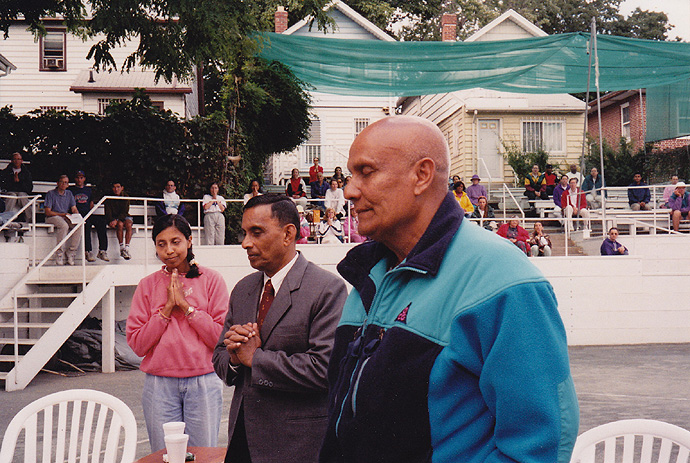 |
|
Here Sri Chinmoy is standing with retired Commodore Arun Ghose and Mahatapa. |
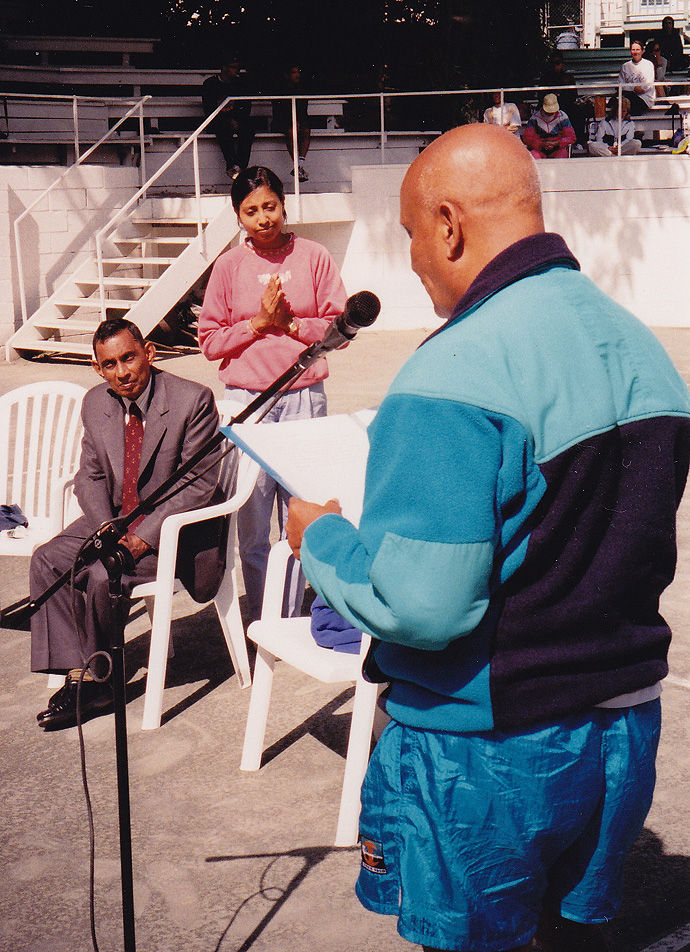 |
|
Sri Chinmoy reads his reminiscences of Dr. Sisirkumar Ghose |
Sisirkumar Ghose
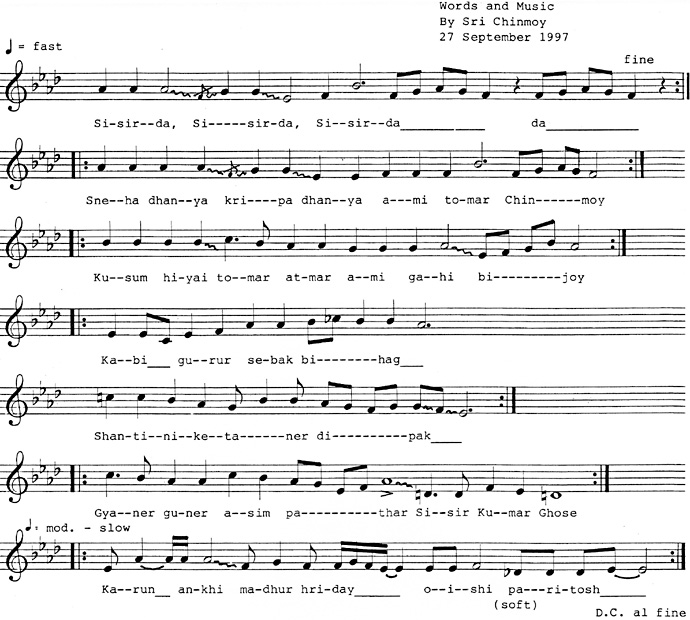 |
Bengali words by Sri Chinmoy:
Sisir-da, Sisir-da, Sisir-da
Sneha dhanya kripa dhanya ami tomar Chinmoy
Kusum hiyai tomar atmar ami gahi bijoy
Kabi gurur sebak bihag shantiniketaner dipak
Gyaner guner asim pathar Sisirkumar Ghose
Karun ankhi madhur hriday oishi paritosh
English translation by Mahatapa Palit:
Sisir-da, Sisir-da, Sisir-da!
I am your affection-blessed, compassion-blessed,
Your very own Chinmoy.
With a flower-heart I sing
Your soul’s victory-joy.
You are the avian servitor
Of the Master-Poet Rabindranath.
Of Shantiniketan,
You are the shining lamp.
Knowledge-talent’s boundless ocean –
Sisir Kumar Ghose!
You are the compassion-eye and
Sweetness-heart of Divine Satisfaction.
– End –
|
Appendix One DR. SISIRKUMAR GHOSE Born:
Education:
Teaching Experience:
Academic Contributions:
Selected Publications:
Selected Abridgements: Sri Aurobindo:
Rabindranath Tagore:
|
|
Appendix Two Excerpts from Sisir-da’s Letters To Vidagdha Bennett9
|
Endnotes:
1 Dr. Sisirkumar Ghose was Mahatapa’s mother’s father’s brother.
2 Sri Chinmoy chose this photograph as the one that reminded him most powerfully of the Sisir-da that he knew.
3 Werner Haubrich – ‘Saumitra’ (meaning ‘friend’) – a coach from Germany, came to the Ashram to give training in athletics and swimming. He stayed for some months and then returned to Germany.
4 In some versions of the story, Sri Chinmoy says, “… and he will make a big noise!”
5 Refer: K. D. Sethna
6 Amal Kiran is the beautiful spiritual name given to K.D. Sethna by Sri Aurobindo. It means ‘purity’.
7 Refer: Amiya Chakravarty
8 Vidagdha Bennett.
9 I corresponded with Sisir-da regularly from 1982 until a year or so before his passing, when he became blind.
10 Prime Minister Rajiv Gandhi released the monograph.

